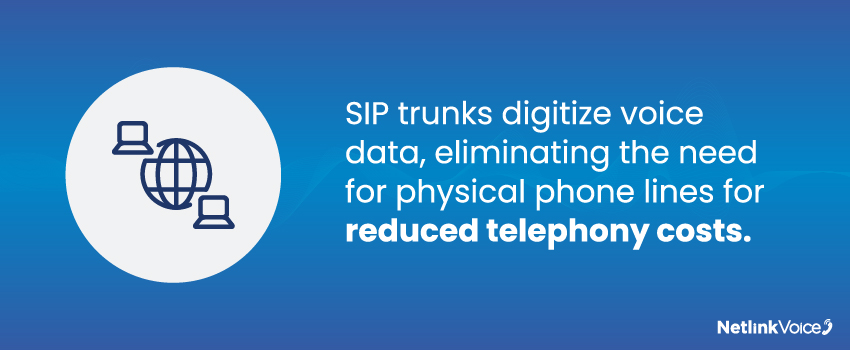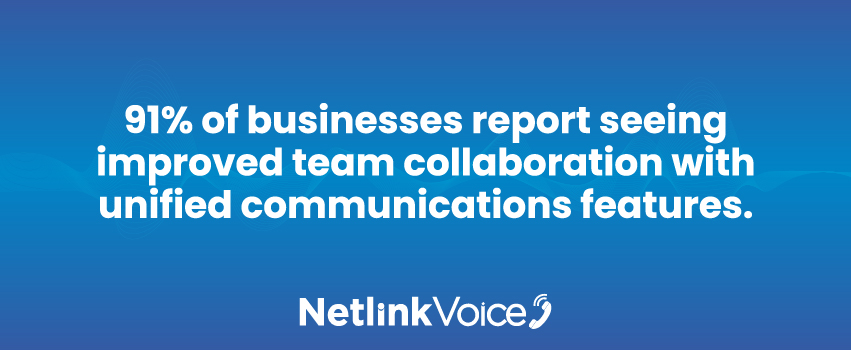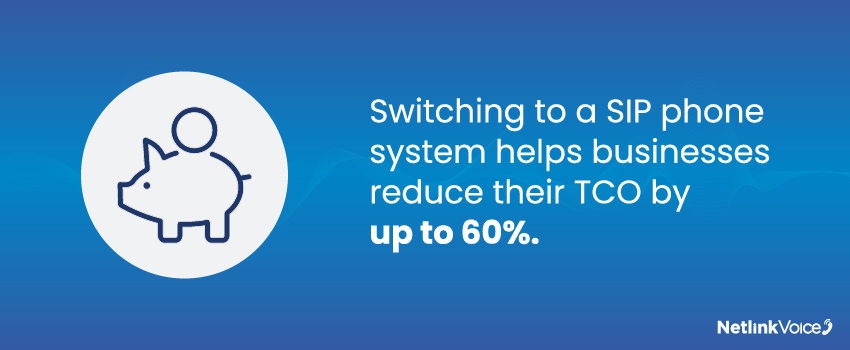SIP trunking is quickly becoming a preferred method for business communications. Valued at $12 billion just two years ago, demand for this service is so strong that market analysts expect the global SIP trunking market to reach $43.74 billion by 2031.1 And it’s no wonder why – SIP trunking provides significant advantages over traditional analog phone lines.
But while SIP trunking providers help companies see benefits like reduced business telephony costs, advanced calling features, seamless scalability, and more, many decision-makers still believe they have to stay attached to a legacy physical phone line for reliable connectivity.
If you’re on the fence about switching to SIP trunking, read on to learn what this service is, how it works, and the many benefits it offers your organization.
What Is SIP Trunking?
SIP trunking is a modern phone system technology that connects the Public Switched Telephone Network (PSTN) to an IP PBX using Session Initiation Protocol (SIP). SIP trunking works by leveraging the SIP internet protocol to digitize voice data and package it into data packets, eliminating the need for multiple physical lines. With SIP trunks, businesses can consolidate phone calls traditionally sent over analog lines with other communication channels, such as video calls, into a single IP pathway.
What Is The Difference Between SIP Trunking & VoIP?
Scope & Use Cases
- VoIP encompasses a range of applications, from consumer-grade services like Skype or WhatsApp to enterprise solutions. It can be used for one-on-one calls, group calls, and even video conferencing.
- SIP Trunking specifically applies to business telephony, acting as the bridge between an on-premises phone system (PBX) and the internet. SIP Trunking is designed for organizations that want to replace traditional phone lines with a cost-effective, scalable solution to handle high volumes of inbound and outbound calls and support multiple types of communication (voice, video, etc.).
Technology & Protocols
- VoIP technology can use various protocols to manage call data, including SIP, H.323, and proprietary protocols (e.g., Skype’s protocol). Each protocol has a different approach to managing calls, data transfer, and media encryption.
- SIP Trunking relies exclusively on the SIP protocol to establish and control communication sessions. This is advantageous because SIP supports multiple media types (voice, video, and text) within a single protocol, allowing businesses to streamline their communications infrastructure.
Infrastructure Requirements
- VoIP services often require just a reliable internet connection, compatible devices (phones, softphones, etc.), and an account with a VoIP provider. For example, a small business can easily adopt VoIP with minimal equipment and software.
- SIP Trunking requires additional infrastructure, specifically a SIP-enabled PBX (or a SIP Gateway if using a legacy PBX). The SIP trunk acts as a replacement for physical telephone lines, connecting the PBX to the internet and enabling simultaneous calls over a single connection. This makes SIP Trunking more suitable for medium to large businesses that need robust, scalable communication solutions.
Cost Structure & Scalability
- VoIP services are typically charged on a per-user or per-device basis, making it an affordable option for small businesses or individual users.
- SIP Trunking offers a more flexible pricing model based on the number of simultaneous call sessions (or channels) rather than individual users. This means a business can add or reduce channels to adjust for call volume, making it highly scalable and cost-effective for larger organizations that handle significant call traffic.
Compatibility With Multimedia & Unified Communications
- VoIP services are usually limited to voice and, in some cases, video calls, depending on the provider and setup.
- SIP Trunking is inherently multimedia-capable and can support voice, video, messaging, and even real-time collaboration tools. This makes it a core technology for unified communications (UC) platforms, where different forms of communication are consolidated for seamless integration and workflow management.
Reliability & Redundancy
- VoIP services may not always offer the same level of reliability, as they can rely on third-party networks or individual user internet connections.
- SIP Trunking providers often offer SLAs (Service Level Agreements) with higher reliability, redundancy options, and failover capabilities, making it suitable for critical business operations. SIP Trunks can be configured with backup trunks or alternative routes to ensure continuous operation during an outage.
In summary, while VoIP is a broad term for internet-based voice calling, SIP Trunking is a business-oriented application within VoIP that serves as a scalable replacement for traditional phone lines. SIP Trunking leverages the SIP protocol to facilitate a wide range of communication types, providing enhanced flexibility, reliability, and integration options for businesses.
Why Do Businesses Choose SIP Trunking?
Most companies pay for phone service based on the number of phone lines activated, plus additional fees for long-distance calls, international calls, service charges, repairs, and upgrades. With rising costs for the digital services needed to stay competitive, like video conferencing, SMS, instant messaging, and file-sharing platforms, the total cost of communications keeps increasing.
Although workaround solutions helped businesses overcome the limitations of analog phone lines initially, many soon realized this patchwork approach to modern communication was inefficient and costly over time. SIP trunking overcomes these challenges by offering a consolidated, user-friendly solution that reduces overhead costs and boosts workplace efficiency.
SIP trunk providers can deliver everything a business needs for communication in one scalable business phone system. Instead of paying for features or functionality your teams don’t even use, SIP trunking lets you pay only for the services and capacity your business needs – while offering an easy way to add advanced unified communications capabilities as your needs change.

11 Biggest Benefits of SIP Trunking
SIP trunking provides businesses with a host of advantages compared to legacy landline systems, including:
1. Lower Monthly Service Costs
One major advantage of SIP trunking is substantially lower monthly phone bills. Rather than paying for services like local, long-distance, equipment rental, and system maintenance separately, SIP trunks consolidate all of these into a single predictable price per user or channel. No more surprise service charges or costly upgrades are required down the road, resulting in greater monthly cost savings.
2. Upgrade Without Hardware Investments
With SIP trunking, scaling your phone system capabilities is possible without having to make significant capital investments in physical infrastructure – which is how switching to a SIP phone system reduces the total cost of ownership (TCO) by up to 60%.2 SIP trunks use software and existing IP networking hardware rather than proprietary equipment from a phone service provider. This means adding new features or capacity doesn’t require purchasing expensive hardware but can be handled through your SIP provider instead.
3. Exceptional Call Quality
For businesses with a reliable internet connection, SIP trunking provides superb clarity and consistency on phone calls. Many systems offer jitter buffers to compensate for telephone network inconsistencies and QoS prioritization for crystal clear audio, rivaling or exceeding traditional phone lines. These enhancements ensure both your team and your customers have an optimal communication experience.
4. Greater International Mobility
If your business is growing across several geographic locations worldwide, SIP trunks let you consolidate voice and data into a single network. This combines your locations and remote workers for simplified communications management and lets you add more virtual phone lines as you open additional locations or hire geographically dispersed workers.
5. Built-In Backup for Business Continuity
SIP providers typically offer full redundancy and automatic failover capabilities built into your system to keep your organization connected during a disaster. Backend infrastructure stays protected since SIP phone systems are delivered via the cloud rather than an on-site PBX box. Additionally, call routing adapts so that sessions reroute through data centers unimpacted by local outages to keep your teams collaborating and serving customers without disruption.
6. Unified Communications Features
A recent survey found that unified communication solutions helped 72% of businesses increase productivity and 91% improve team collaboration.3 SIP makes it easy to consolidate all your communications capabilities, including instant messages, video calls, screen sharing, file transfer, and more, under one unified system. Plus, features like call routing and recording can ensure your clients are always connected to the right department or representative to enhance the customer service experience.

7. Keep Existing Phone Numbers
SIP systems allow you to port over any existing business, toll-free, and fax numbers, reducing disruptions as your organization makes the transition. Customers can dial the same numbers they’re familiar with, while your business saves on reprinting or updating existing materials.
8. Right-Sized Voice Channels
SIP trunking allows you to right-size channel capacity for each location’s needs while sharing resources efficiently company-wide. For example, 100 call channels could flex across 10 offices rather than each having 10 dedicated channels. This adaptation uses fewer overall resources, driving shared savings and making it possible to scale up or down dynamically to respond to changing demands.
9. Data Insights for Smarter Decisions
SIP trunks offer robust reporting and monitoring capabilities to provide insightful statistics that optimize your enterprise communications infrastructure. By understanding calling patterns and peak demand trends, you can make smarter decisions to utilize resources appropriately. Diagnostic session logs also speed up troubleshooting when needed.
10. Seamless Scalability as You Grow
Cloud delivery and software make scaling SIP phone solutions to support multiple locations frictionless. Setting up a new office takes days rather than weeks, and you can quickly onboard new acquisitions or handle seasonal traffic spikes by adding more capacity via your SIP provider’s portal.
11. Reduced Ongoing Maintenance Hassles
Proactive monitoring and preventative maintenance from your SIP provider can help minimize system failures and unplanned downtime. This means no more juggling equipment warranty contracts and service calls when issues arise. Additionally, remote software upgrades and patches are easy to roll out to the entire organization, so your internal IT teams can spend less time tackling communication issues and working on other projects instead.
How Can Businesses Switch to SIP Trunking?
If the prospect of migrating your business communications to SIP trunking seems daunting, rest assured that the right SIP provider can make the process smooth and headache-free. Here’s a look at what’s involved when switching over:
Number Porting
One major concern when changing phone systems is having to distribute new phone numbers to your contacts. However, SIP providers can port your existing business phone numbers to the new system, ensuring minimal disruption during the transition.
Staff Training
Your SIP trunking provider should offer the resources to train employees on your new phone system’s features, improved software interface, and additional capabilities like video conferencing. Their support can ensure your team gets up to speed quickly so productivity doesn’t lag.
Testing Period
Before going live, use a pilot testing phase where select staff use the new SIP trunking service in parallel with your legacy setup. Monitoring call connectivity and quality, feature responsiveness, and other aspects of the new system can help resolve hiccups before the full roll-out.
Gradual Roll-Out
With testing complete and all staff trained on the new system, you can shift users over to the SIP connections in controlled phases. Leave legacy lines active during the transition so that rollback is possible if needed, shutting them down only after the full cutover. The right SIP trunking service provider can assist throughout the process.

Take Full Advantage of SIP Trunks with Netlink Voice
As physical copper lines continue to be retired and modern IP PBX systems become mainstream, now is the ideal time to future-proof your business with SIP services. Transitioning to SIP trunking now can help you reduce expenses and boost capabilities beyond what traditional phone lines can offer – while preparing your business for the future.
At Netlink Voice, we make it easy for businesses to unlock the advantages of SIP trunking with a solution that works seamlessly with your existing PBX system. Unlimited nationwide long-distance comes standard, and you can add more lines any time you need them so that you always know what you’re paying each month. Plus, our self-healing network architecture guarantees uptime, with automatic disaster recovery that automatically reroutes your phone calls in case of an outage.
Ready to get started with a cost-effective, cloud-based SIP trunking solution? Reach out to the Netlink Voice team today!
Sources:
